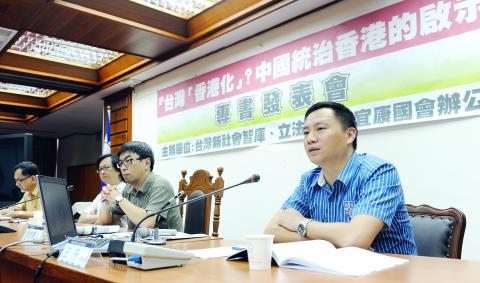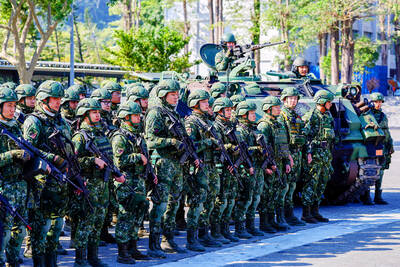Taiwan has paid too little attention to the civil movement in Hong Kong and could be the next in line to be absorbed by Beijing if the trend continues, politicians and political observers said at a panel discussion in Taipei yesterday.
Hong Kong, which was handed back to China by the UK in 1997, could serve as a perfect example for Taiwan in its efforts to defy Chinese political pressure and influence, said Wang Dan (王丹), a Chinese dissident who now teaches at National Tsinghua University in Hsinchu.
Wang was one of the guest speakers at a panel discussion on the theme of “Taiwan’s Hong Kong-ization,” which is also the theme of a book published by New Society for Taiwan, a think tank and co-organizer of the event.

Photo: Chang Chia-ming, Taipei Times
Democratic Progressive Party (DPP) Legislator Tuan Yi-kang (段宜康), the other co-organizer, moderated the discussion.
Taiwan has already been “Hong Kong-ized,” Wang said, because government agencies, institutions and media outlets have all learned to “self-discipline” themselves in what can and cannot be done in much the same fashion as their Hong Kong counterparts prior to the 1997 handover.
Second, as with Hong Kong, China has used its economic power to influence Taiwanese politics, Wang said.
Wang agreed with the idea of advocating a “cross-strait alliance of civil movements” between people in China, Hong Kong and Taiwan, saying that it could be the only effective way to stop Taiwan from “Hong Kong-ization.”
Wang predicted that the increasing political participation of those born after 1990 would play a critical role in Hong Kong’s civil movement in the future because this young generation is now “even more anti-communist than their parents and more active in speaking their minds and participating in politics.”
Emily Lau (劉慧卿), a member of the Legislative Council of Hong Kong and vice president of the Hong Kong Democratic Party, said via video teleconference that China had not won the hearts of people in Hong Kong even 15 years after the handover.
The “one country, two systems” mechanism was originally designed by Beijing for Taiwan, but it was implemented in Hong Kong first, Lau said, adding that the results and process of the implementation could serve as a reference for Taiwan.
Chang Tieh-chih (張鐵志), a political commentator, said China has been getting impatient with the civil movement in Hong Kong in recent years, but everything it did “pushed Hong Kong people further from China.”
Hong Kong paid little attention to Taiwan in the past, former DPP legislator Lin Chuo-shui (林濁水) said, even though both have walked similar historical paths — both were ceded by China after wars and both advanced economically before China.
However, both sides appeared to “connect” to each other after the 1997 handover as people in Hong Kong looked to Taiwan as a political inspiration and model.
In a recent poll, Taiwan ranked as the favorite foreign nation among Hong Kong residents, he said, adding that “a democratic Taiwan out of China’s control would be a pillar for Hong Kong’s democratic movement.”

UNILATERAL MOVES: Officials have raised concerns that Beijing could try to exert economic control over Kinmen in a key development plan next year The Civil Aviation Administration (CAA) yesterday said that China has so far failed to provide any information about a new airport expected to open next year that is less than 10km from a Taiwanese airport, raising flight safety concerns. Xiamen Xiangan International Airport is only about 3km at its closest point from the islands in Kinmen County — the scene of on-off fighting during the Cold War — and construction work can be seen and heard clearly from the Taiwan side. In a written statement sent to Reuters, the CAA said that airports close to each other need detailed advanced

Tropical Storm Fung-Wong would likely strengthen into a typhoon later today as it continues moving westward across the Pacific before heading in Taiwan’s direction next week, the Central Weather Administration (CWA) said. As of 8am, Fung-Wong was about 2,190km east-southeast of Cape Oluanpi (鵝鑾鼻), Taiwan’s southernmost point, moving westward at 25kph and possibly accelerating to 31kph, CWA data showed. The tropical storm is currently over waters east of the Philippines and still far from Taiwan, CWA forecaster Tseng Chao-cheng (曾昭誠) said, adding that it could likely strengthen into a typhoon later in the day. It is forecast to reach the South China Sea

Almost a quarter of volunteer soldiers who signed up from 2021 to last year have sought early discharge, the Legislative Yuan’s Budget Center said in a report. The report said that 12,884 of 52,674 people who volunteered in the period had sought an early exit from the military, returning NT$895.96 million (US$28.86 million) to the government. In 2021, there was a 105.34 percent rise in the volunteer recruitment rate, but the number has steadily declined since then, missing recruitment targets, the Chinese-language United Daily News said, citing the report. In 2021, only 521 volunteers dropped out of the military, the report said, citing

WEATHER Typhoon forming: CWA A tropical depression is expected to form into a typhoon as early as today, the Central Weather Administration (CWA) said yesterday, adding that the storm’s path remains uncertain. Before the weekend, it would move toward the Philippines, the agency said. Some time around Monday next week, it might reach a turning point, either veering north toward waters east of Taiwan or continuing westward across the Philippines, the CWA said. Meanwhile, the eye of Typhoon Kalmaegi was 1,310km south-southeast of Oluanpi (鵝鑾鼻), Taiwan’s southernmost point, as of 2am yesterday, it said. The storm is forecast to move through central